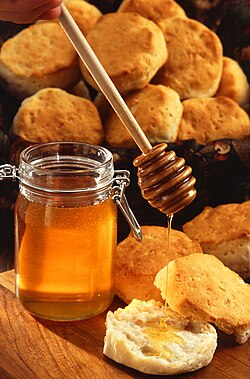**1. Honey Production and Processing:**
– Bees collect nectar or honeydew to produce honey.
– Bees regurgitate nectar into the honey stomach for digestion.
– Average hive production is around 29 kilograms (65lb) of honey annually.
– Preservation methods ensure honey remains unadulterated.
– Honey is extracted by crushing honeycombs or using a honey extractor.
– Different processing methods include raw honey, strained honey, filtered honey, ultrasonicated honey, and creamed honey.
– Types of honey include dried honey, comb honey, chunk honey, and bakers honey.
**2. Honey Properties and Characteristics:**
– Honey water content ranges from 15.5% to 18%.
– Honey has a long shelf life due to its chemical properties.
– Melting point of crystallized honey is 40-50°C (104-122°F).
– Honey has a glass transition temperature of -42 to -51°C (-44 to -60°F).
– Viscosity, electrical conductivity, refractive index, and hygroscopic nature are key properties of honey.
– Thermal characteristics include caramelization process, Maillard reaction, and thermal conductivity.
– Acid content affects flavor, with an average pH of 3.9.
– Honey contains over 100 volatile organic compounds (VOCs) that determine flavor and aroma.
**3. Beekeeping and Honey Adulteration:**
– Honey bees are semi-domesticated by humans for honey, pollen, wax, and resins.
– Commercial beekeeping focuses on maximizing honeycomb production and preventing swarming.
– Honey adulteration is practiced to change flavor or reduce costs.
– Global honey production in 2020 was 1.8 million tonnes.
– Isotope ratio mass spectrometry is used to detect honey adulteration.
**4. Classification and Grading of Honey:**
– Honey is classified by floral source as monofloral, polyfloral, or blended.
– Honey grading standards vary by country, with the US grading based on color, water content, and absence of defects.
– India certifies honey grades based on factors like the Fiehes test.
– Regional honeys are identified and classified by the Pfund scale.
**5. Uses and Indicators of Quality of Honey:**
– Honey is used in cooking, baking, desserts, and as a sweetener.
– Mead, the world’s oldest fermented beverage, is made from honey.
– High-quality honey is distinguished by fragrance, taste, and consistency.
– Processing methods like raw honey, strained honey, and creamed honey cater to different preferences.
– Indicators of quality include flow consistency, bead formation, viscosity, and appearance.
Honey is a sweet and viscous substance made by several species of bees, the best-known of which are honey bees. Honey is made and stored to nourish bee colonies. Bees produce honey by gathering and then refining the sugary secretions of plants (primarily floral nectar) or the secretions of other insects, like the honeydew of aphids. This refinement takes place both within individual bees, through regurgitation and enzymatic activity, and during storage in the hive, through water evaporation that concentrates the honey's sugars until it is thick and viscous.
Honey bees stockpile honey in the hive. Within the hive is a structure made from wax called honeycomb. The honeycomb is made up of hundreds or thousands of hexagonal cells, into which the bees regurgitate honey for storage. Other honey-producing species of bee store the substance in different structures, such as the pots made of wax and resin used by the stingless bee.
Honey for human consumption is collected from wild bee colonies, or from the hives of domesticated bees. The honey produced by honey bees is the most familiar to humans, thanks to its worldwide commercial production and availability. The husbandry of bees is known as beekeeping or apiculture, with the cultivation of stingless bees usually referred to as meliponiculture.
Honey is sweet because of its high concentrations of the monosaccharides fructose and glucose. It has about the same relative sweetness as sucrose (table sugar). One standard tablespoon (15 mL) of honey provides around 190 kilojoules (46 kilocalories) of food energy. It has attractive chemical properties for baking and a distinctive flavor when used as a sweetener. Most microorganisms cannot grow in honey and sealed honey therefore does not spoil. Samples of honey discovered in archaeological contexts have proven edible even after millennia.

Honey use and production has a long and varied history, with its beginnings in prehistoric times. Several cave paintings in Cuevas de la Araña in Spain depict humans foraging for honey at least 8,000 years ago. While Apis melifera is an Old World insect, large-scale meliponiculture of New World stingless bees has been practiced by Mayans since pre-Columbian times.

